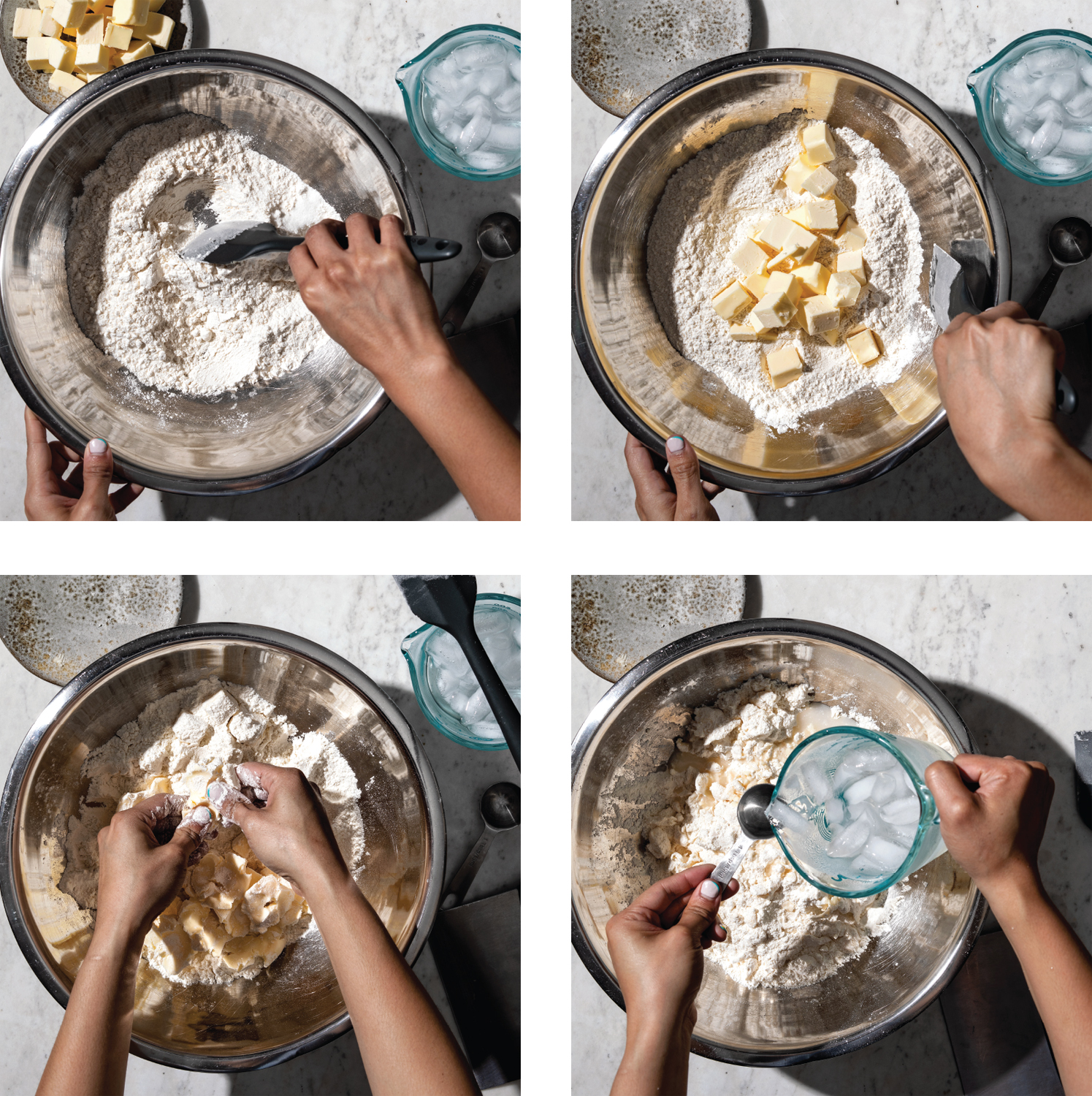WHITE
MAKES 1 DISK OF PIE DOUGH, TO MAKE A SINGLE-CRUST PIE
This is the foundational piece for making all your pie dreams come alive. Master this dough and you master them all. While the ingredient quantities may differ slightly for the naturally colored dough variations, the process remains the same. Dry ingredients get tossed together, the butter jumps in next, and then the liquid is added as the last step. Follow this formula for both the manual and food processor methods across the spectrum of colors.
Pay careful attention to the number of dough disks called for in each design recipe. In the case where multiple disks of the same type of dough are required, I recommend doubling the recipe and making two disks at a time. In fact, since freezing pie dough is so easy and effective, I often make two disks at a time even when I’m making a single-crust pie, saving the spare for an expedited future baking session.
½ cup ice
½ cup (118 milliliters) cold water
1¼ cups (175 grams) all-purpose flour
½ tablespoon granulated sugar
½ teaspoon kosher salt
½ cup (1 stick/113 grams) cold unsalted butter, cut into ½-inch cubes
MANUAL METHOD
1. Combine the ice and water in a small cup or bowl. Set aside.
2. Put the flour, sugar, and salt in a large bowl and stir with a spatula to combine.
3. Sprinkle in the butter cubes and toss until each cube is coated in the flour mixture.
4. Flatten each cube of butter with your pointer fingers and thumbs. Toss again to coat the flattened butter pieces. Continue massaging the butter into the flour until the remaining shards resemble cornflakes in a range of sizes.
5. Add 2 tablespoons of the cold water, taking care not to include any ice, and fluff the moisture through the flour with a spatula. Continue adding cold water 1 tablespoon at a time, pressing the dough with a spatula after each addition until it begins to come together. Avoid any heavy kneading, as overworking the dough will lead to a tough crust.
6. If the dough still has quite a bit of dry mix and doesn’t hold together when a handful is squeezed, add a little more water. Be careful not to add too much water (usually 3 to 5 tablespoons total are sufficient). The dough should be smooth and supple. If the dough is quite tacky, you’ve likely added too much liquid. Try gently incorporating a little more flour. If it is still very sticky, I suggest starting over with a new batch of ingredients. Overly hydrated dough will be difficult to roll out and utilize in these designs, and the crust will likely be tough when baked. Pie fries or pie cookies may be a suitable option for keeping the handling to a minimum and avoiding outright waste of the dough.
7. When the dough begins to hold together, turn it out onto your work surface and gently form it into a rounded mound with your hands. Wrap the dough tightly in plastic, then gently press it into a round, flat disk, about 5 inches in diameter and 1 inch in thickness. Refrigerate for at least 3 hours or overnight before rolling. Resting the dough in the fridge allows the gluten to relax and the dough to fully hydrate, and prevents shrinkage during baking. If you plan to freeze the pie dough, do so only after the rest period of at least 3 hours in the fridge.
8. Use the dough in the recipe of your choice.


FOOD PROCESSOR METHOD
1. Combine the ice and water in a small cup or bowl. Set aside.
2. Put the flour, sugar, and salt in a food processor and pulse several times to incorporate. Sprinkle the butter cubes evenly over the surface of the dry mixture and pulse quickly 20 to 25 times to break up the cubes into small jaggedy pieces.
3. Turn the mixture out into a large mixing bowl. Sift through with a spatula for unprocessed butter cubes and flatten any pieces larger than a pecan half with your pointer finger and thumb.
4. Add 2 tablespoons of the cold water, taking care not to include any ice, and stir through with a spatula. Continue adding water 1 tablespoon at a time, pressing the dough with your hands or a spatula after each addition until it begins to come together. Avoid any heavy kneading, as overworking the dough will lead to a tough crust.
5. If the dough still has quite a bit of dry mix and doesn’t hold together when a handful is squeezed, add a little more water. Be careful not to add too much water (usually 3 to 5 tablespoons total are sufficient). The dough should be smooth and supple.
6. When the dough begins to hold together, turn it out onto your work surface and gently form it into a mound with your hands. Wrap the dough tightly in plastic, then gently press it into a round, flat disk, about 5 inches in diameter and 1 inch in thickness. Refrigerate for at least 3 hours or overnight before rolling. Resting the dough in the fridge allows the gluten to relax and the dough to fully hydrate, and prevents shrinkage during baking. If you plan to freeze the pie dough, do so only after the rest period of at least 3 hours in the fridge.
7. Use the dough in the recipe of your choice.